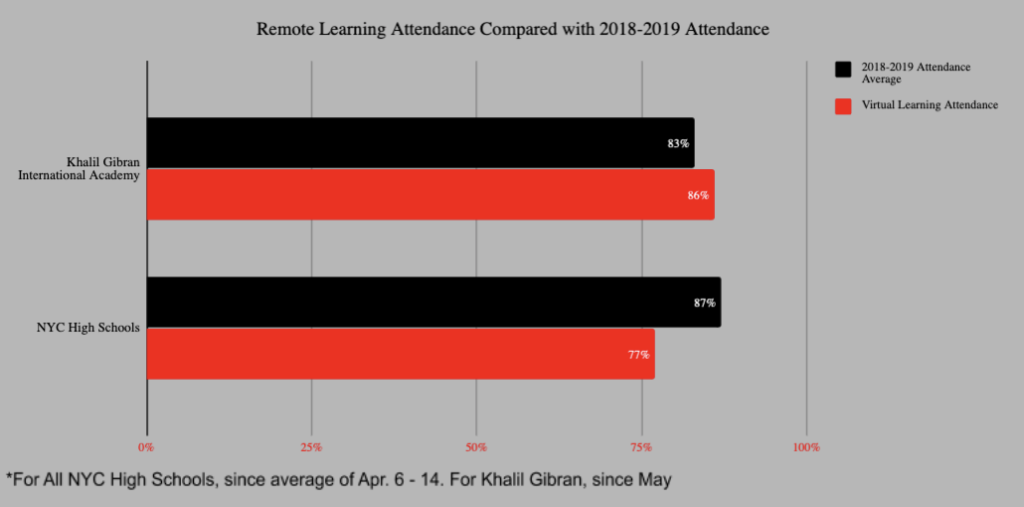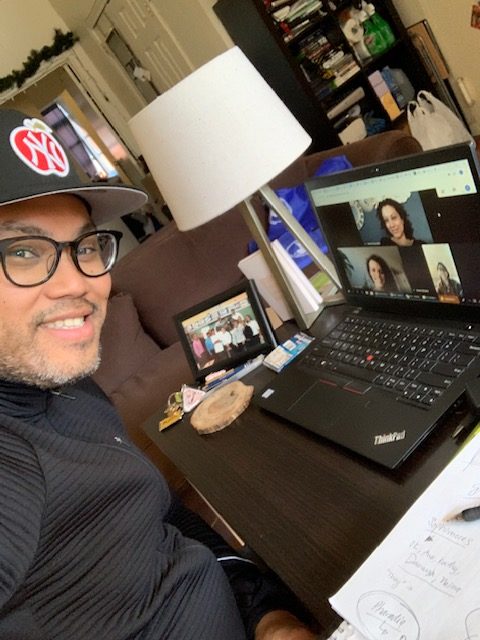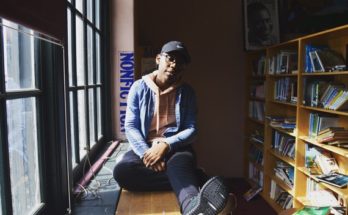While teachers and students scrambled to adjust to virtual learning in the immediate aftermath of the coronavirus all-school shut down, long-term goals — like corralling runaway attendance rates — for some struggling schools were sidelined by necessity. Khalil Gibran International Academy, a public high school in Boerum Park Brooklyn, was in the midst of an aggressive initiative of its own to address its poor attendance record when COVID-19 struck. The school’s average absentee rate had hovered at 44% in recent years, compared to a citywide rate of about 25 percent.
In December of last year, Khalil Gibran welcomed a new principal who brought with him a track record of success in boosting attendance. At Carl Manalo’s last school, Queens High School for Information, Research and Technology, he was celebrated for raising the school’s graduation rates up from 55 percent in 2014 to 70 percent by 2017. As soon as he arrived at Khalil Gibran, Manalo said his main priority this school year and next would be to do everything possible to improve the school’s graduation and attendance rates.
But during the past two months, Manalo has had to refocus his attention to new attendance measurements and the shift to online learning. He says new ways of measuring attendance have been implemented in phases, starting with the weeks-long process of making sure students had Wi-Fi and devices to use at home, because if students couldn’t access their classes online, there would be no way to measure attendance or engagement.
Then, teachers had to balance assigning homework and ensuring students wouldn’t be penalized for missing work they were unable to complete because they couldn’t yet access their virtual courses. Under virtual learning parameters, attendance is more focused on participation than it would be during in-person instruction.
“Things have shifted because we’re no longer just checking regular attendance. It’s now the level of engagement students have,” Manalo explained. He said students are now marked as present for the day after logging into one course, as opposed to needing to be marked present for several classes per day during normal circumstances. Before COVID-19, nine staff members at the high school were working together as a team every week to check in on absent students and make sure parents have been contacted. If a student missed one day of school, a teacher would be expected to follow-up and discuss the absence the next day.

But since mid-March teachers have been forced to turn their full attention to facilitating online learning, ensuring as many students as possible have devices and internet access, and getting students who have fallen behind amid the chaos back on track. “The first couple of weeks were basically about getting kids online and trying to figure out what the issue is for the kids who are not online,” teacher Jennifer DeFilippo said.
DeFilippo said in recent weeks teachers have been taking attendance based on “meaningful student engagement and interactions.” A meaningful interaction could be counted if a student attended the live lesson for class or for participating in the related chat or forum discussion,” said DeFilippo, who is an active member of the attendance support team. If a student does not attend the online lesson, they might still be able to earn credit for completing an assignment or reaching out to a teacher by email or phone.
“Basically anything that the principal deems to be a meaningful interaction counts for student attendance,” said DeFilippo, who wears many hats at the Brooklyn high school. In addition to teaching three classes, she coordinates all of the school’s standardized testing, such as the Regents exams and SAT testing. She coordinates all of the high school’s after school programs, from college application support programming to a robotics group to a boxing class.
Under normal circumstances, the school would have nine staff members who would be working together to keep track of absent students, make contact with their parents to check in and take any necessary next steps. As teachers have had to figure out online learning methods, that system has shifted.
Some of these shifts have been easier to implement than others. For the first couple of weeks of at-home learning, DeFilippo said it was mostly out-of-classroom staff members who were doing the bulk of the attendance outreach.The high school’s parent coordinator, guidance counselors and community associate were the ones focusing on attendance while teachers were adapting to online lessons, she said.

Around March 15, Khalil Gibran started using a block schedule, which structures courses more simply so that students have four core subjects to focus on: math, science, English and history.
Staff members were calling kids and parents each morning, trying to figure out who did and didn’t have internet access and who needed a device. Teachers were also responsible for calling all the students who were not logging into online classes for them, DeFilippo said.
For example, DeFilippo is expected to make outreach calls to students who are not logging in to her class on the days she does not teach math. staff members were calling kids and parents each morning, trying to figure out who did and didn’t have internet access and who needed a device. Teachers were also responsible for calling all the students who were not logging into online classes for them, DeFilippo said. For example, DeFilippo is expected to make outreach calls to students who are not logging in to her class on the days she does not teach math.
Fridays have been used for office hours and administrative duties, as well as attendance meetings to discuss which students might need next steps. In this situation, a next step might lead to a call to the city’s Administration for Children’s Services, which handles child safety issues.
The high school used to have an attendance teacher who would do home visits to check in on frequently absent students, but under the current national social distancing guidelines, she’s no longer doing those visits.
That teacher still serves as a next step to do continued phone or social media outreach, but since she’s not doing home visits, Khalil Gibran’s main form of next steps for kids who are under 17 and a half is to call ACS because the agency is still doing home visits to children.
“So if I have a 15-year-old ninth grader who we have not been able to make any contact with and who is not attending virtual school, that’s now educational neglect and that’s an ACS case,” DeFilippo said. “But we try to do everything on our end first before we start sending ACS workers out.
Another change due to the school shut down has been the eliminated requirement for students to pass the Regents exam to graduate. At Khalil Gibran, this may mean some “super senior” students, those who remain enrolled beyond the traditional four-year period and in need of additional credits or exams to graduate, will now graduate sooner than expected.
“A lot of our kids who might not have graduated are going to graduate now,” DeFilippo
said.
A previous version of the above graphic on remote learning attendance included figures from April 2020. The graphic has been updated to show data from May 2020.



